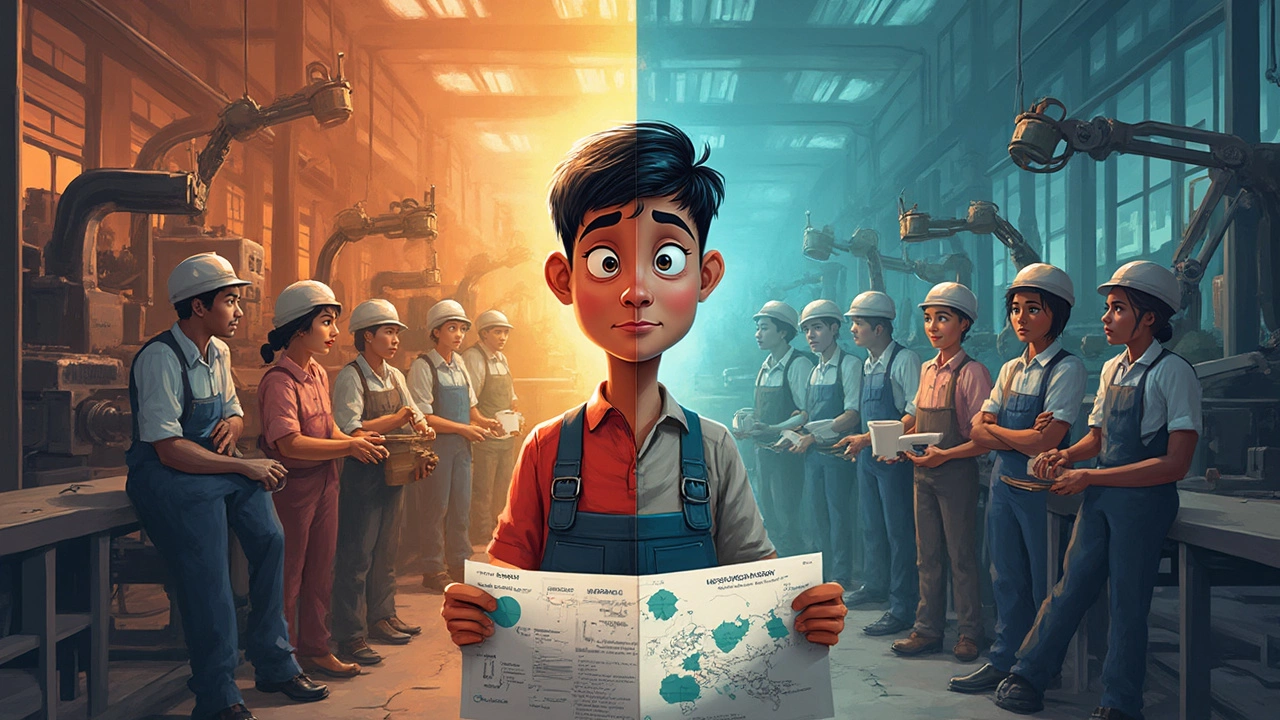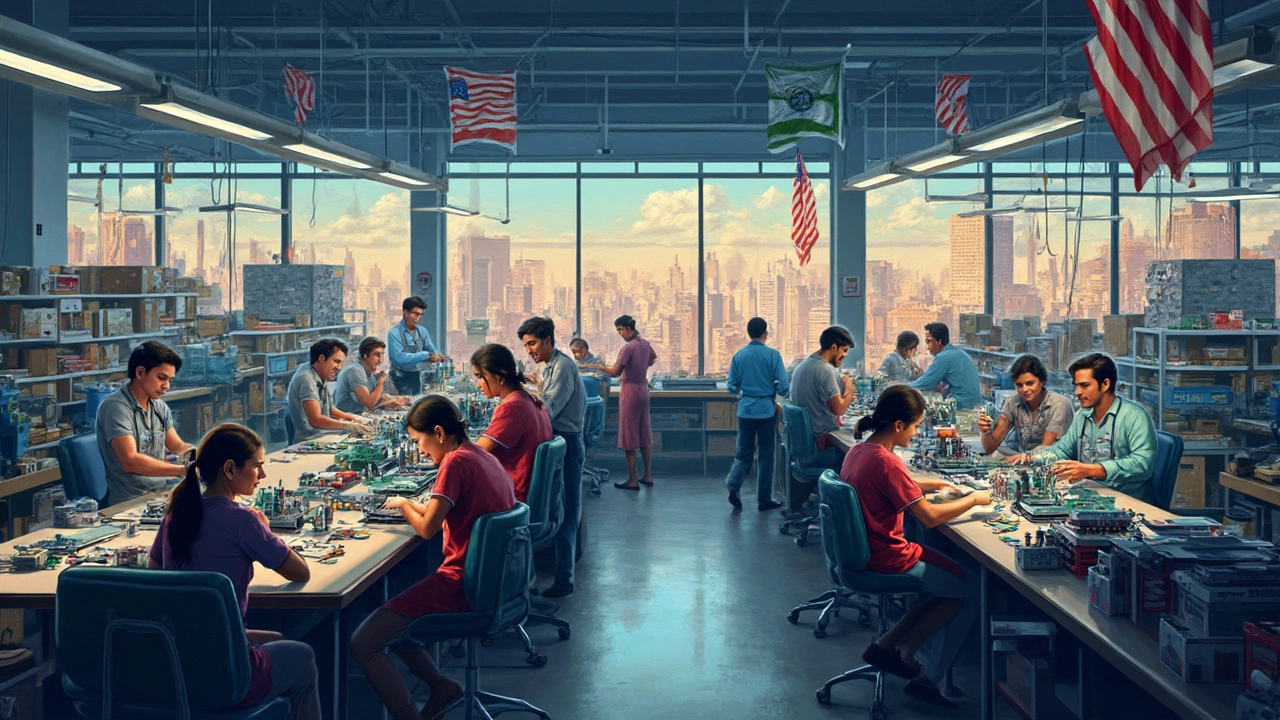Folks keep asking if anything is still made in the U.S. anymore. Honestly, you might be surprised by the answer. Sure, walk through any big retail store and dozens of labels say 'Made in China' or 'Vietnam.' But right under our noses, the U.S. is still putting out a ton of stuff—from jet engines to cheese, and even some of your favorite pickup trucks.
There’s a myth that everything moved offshore for good back in the 90s. But U.S. factories never closed up shop entirely—they just shifted gears. American companies still crank out about $2 trillion worth of goods every year. That’s stuff you probably depend on every day: medical equipment, cars, high-tech chips (especially with all the new government funding for semiconductors), and, yes, tons of food items.
If you’re curious about what’s actually produced here, it’s not just old-school steel or tractors. Think aerospace, pharmaceuticals, electric vehicle batteries, and craft beer. And that’s before we even get to heavy-hitters like Boeing planes or Caterpillar machines that power projects worldwide.
- What's Still Made Here?
- Why So Many Factories Left
- Government Plans and Incentives
- Revival Stories: Manufacturing Comebacks
- How You Can Find American-Made Products
What's Still Made Here?
When people talk about U.S. manufacturing, most don’t realize just how much the country still produces. Sure, a lot of clothes and electronics are imported, but America is a powerhouse when it comes to heavy industry, food, vehicles, and high-tech products.
Check out these everyday things still made right at home:
- Jet engines and airplanes – Boeing and GE still build world-class planes and engines in places like Seattle and Cincinnati.
- Automobiles – Ford, GM, and Tesla crank out millions of cars and trucks in Michigan, Texas, and California.
- Pharmaceuticals – Drug manufacturing is big in New Jersey and North Carolina, where a lot of prescription meds are still mixed.
- Food and beverages – Think Wisconsin cheese, California wine, and craft beer brewed in almost every state.
- Machinery and equipment – Caterpillar and John Deere export hundreds of thousands of excavators and tractors worldwide.
- Microchips – Thanks to big investments, companies like Intel and Micron are expanding chip production in Arizona and Idaho.
"As of 2024, U.S. manufacturing output is the second highest in the world, behind only China. While the mix has shifted, the numbers show the story isn’t as bleak as sometimes painted." — National Association of Manufacturers
Just to put it into perspective, here’s a taste of what’s being produced in the U.S. today:
| Product Category | Top Producing States | Key Players |
|---|---|---|
| Vehicles & Automotive Parts | Michigan, Ohio, Texas | Ford, GM, Tesla |
| Aerospace Products | Washington, California, Kansas | Boeing, Lockheed Martin |
| Electronics & Semiconductors | Arizona, California, Idaho | Intel, Micron |
| Food & Beverages | California, Wisconsin, Minnesota | Gallo, Kraft Heinz |
| Pharmaceuticals | New Jersey, North Carolina, Pennsylvania | Pfizer, Merck |
You probably use something made in America every single day—maybe it’s the medicine in your cabinet, the snacks in your pantry, or the car in your garage. The real shift? Factories are more high-tech and more focused on quality and precision, less about cheap, mass-produced stuff. And that's what keeps manufacturing in the U.S. alive and kicking.
Why So Many Factories Left
Ever noticed how the label “Made in USA” seems rarer these days? There’s a reason: Over the last forty years, factories packed up and moved out. It's not just nostalgia—real jobs disappeared. The 2000s were brutal: the U.S. lost about 5.5 million manufacturing jobs between 2000 and 2010. Most of those jobs didn’t just vanish; they moved overseas where making stuff is cheaper.
So why did this happen? It boils down to a few clear points:
- Cheaper Labor Overseas: Wages in countries like China and Mexico are lower, which means companies save a ton on payroll.
- Trade Policies: Deals like NAFTA in the 90s made it easy to move work to places with looser rules (and lower costs).
- Automation: Robots and smart machines cut the need for people on the factory floor, so fewer workers were needed, period.
- Rising Costs at Home: U.S. costs for things like health care, taxes, and real estate make running a factory a pricey move.
Here's a quick look at how things shifted:
| Year | U.S. Manufacturing Jobs |
|---|---|
| 1980 | 18.5 million |
| 2000 | 17.3 million |
| 2010 | 11.7 million |
| 2023 | 13.2 million |
If you're wondering whether this trend was just about “chasing cheap,” check out what The Brookings Institution said:
“The drive for lower costs and greater efficiency through offshoring became the dominant business strategy through the 1990s and 2000s, fundamentally reshaping the structure of American manufacturing.”
The push for lower prices led to global supply chains—your phone might be ‘designed in California, assembled in China’—and that’s not an accident. But even as factories left, the manufacturing story isn’t over. Some jobs are coming back, and new stuff is being built right here at home, in spots you’d never expect.

Government Plans and Incentives
Uncle Sam isn’t just watching from the sidelines—he’s all in with cash and policies to keep American manufacturing competitive. The last few years, you might’ve heard about some big moves from Washington: massive tax credits, tough new rules favoring American suppliers, and straight-up cash investments in high-tech factories. These aren’t just ideas on paper. Real money is making real changes.
Let’s break down a few headline moves:
- CHIPS and Science Act (2022): The government poured roughly $52 billion into boosting U.S. factories that produce semiconductors. Why? Recent shortages showed how risky it is to depend on overseas chips for everything from cars to phones.
- Inflation Reduction Act (2022): Not just about energy costs, this bill dumped billions into clean energy projects and factories for batteries, electric vehicles, and green tech.
- Buy American rules: Federal projects now have tighter requirements—if a bridge gets built or a school gets solar panels, as much as possible has to come from American factories.
- Manufacturing Extension Partnership: This isn’t new, but got a big funding boost. It links up small manufacturers with tech, training, and business advice to help them keep up.
Want a quick look at the numbers?
| Policy/Program | Year Started | Major Funding | Main Focus |
|---|---|---|---|
| CHIPS and Science Act | 2022 | $52 billion | Semiconductor & Tech Manufacturing |
| Inflation Reduction Act | 2022 | $370 billion (clean energy & incentives) | Green Energy, EVs, Clean Factories |
| Buy American Policy Updates | 2021–2025 | — | Stricter American sourcing for government spending |
| Manufacturing Extension Partnership | 1988 | $158 million/year (2023) | Small Manufacturer Support |
This isn’t just about making stuff here for pride. Keeping American factories buzzing helps secure vital supply chains, provides jobs, and aims to make the U.S. less reliant on unpredictable overseas markets. If you’re eyeing that "Made in USA" label, it’s not a fluke—there’s real muscle (and money) behind it.
Revival Stories: Manufacturing Comebacks
It’s not just talk—American manufacturing is making a comeback in some surprising places. Cities like Detroit and Pittsburgh, which once looked run-down after factories left, are now climbing back with new industries and jobs.
One big example is the semiconductor industry. After decades of relying on chips made mostly in Asia, the CHIPS Act (signed in 2022) pumped billions into building U.S.-based fabs. Intel kicked off construction of two giant chip plants in Ohio in 2023 that are set to employ over 3,000 people once finished. TSMC, the world’s biggest chipmaker from Taiwan, is also investing more than $40 billion in Arizona. That’s turning some desert land into major tech hubs.
Electric vehicle batteries are another hot spot. In Georgia, Hyundai and SK are spending around $5 billion on a new EV battery plant. Ford’s also pouring $3.5 billion into a battery factory in Michigan. These are huge bets that the U.S. will keep building more of the cars that will be on the road for the next generation.
It’s not just the big guys. Plenty of smaller, specialty factories are re-opening, too. In Maine, for instance, New Balance brought back sneaker production lines that had been shuttered for a decade. In Texas, toolmaker Channel Lock built a modern plant to keep hand tool manufacturing local, supporting hundreds of jobs.
| Company | Location | Project Type | Estimated Jobs Created |
|---|---|---|---|
| Intel | Ohio | Semiconductor Plants | 3,000+ |
| TSMC | Arizona | Semiconductor Fabs | 4,500+ |
| Hyundai & SK | Georgia | EV Battery Plant | 8,000+ |
| Ford | Michigan | EV Battery Plant | 2,500+ |
| New Balance | Maine | Sneaker Factory Upgrade | 200+ |
These numbers aren’t record-breaking compared to what manufacturing looked like in the 1950s, but they’re giving towns a pulse again. For lots of families, this means a shot at good, steady work without having to move away. It’s new factories, new skills, and getting America back to building stuff, one step at a time.

How You Can Find American-Made Products
It might feel like finding U.S.-made stuff is a treasure hunt, but you really can spot them without ripping open every box at the store. Start with the label – 'Made in USA' is regulated by the Federal Trade Commission. If you see that phrase, it means all or almost all of the product was built here, not just put together from foreign parts. But here’s a heads up: 'Assembled in USA' might mean most components came from other countries, so don’t get those two mixed up.
Some big brands still manufacture a ton on American soil. For example, Ford F-Series trucks roll out of plants in Dearborn, Michigan and Kentucky. New Balance has five shoe factories in New England churning out sneakers. Even GE Appliances are made in Louisville, Kentucky. So yes, it’s not all nostalgia—real companies make real stuff here.
To help you tell what's what on the shelves or online, here’s a quick cheat sheet:
- Look for the “Made in USA” seal – usually on packaging or somewhere in the product description.
- Skip 'Designed in USA'—that just means the ideas started here, not the actual build.
- For cars, check the window sticker: The American Automobile Labeling Act (AALA) tells you the percentage of U.S./Canadian parts and where the car’s assembled.
- Online shops like Made in America Store and BuyDirectUSA focus only on products that are genuinely U.S.-made.
- When shopping online, use filters or search "American-made" in product descriptions on sites like Amazon. There’s even a program called Amazon’s "Made in USA" badge.
Here’s a look at the industries where finding U.S. products is common:
| Industry | % of Domestic Production | Easy-to-Find Products |
|---|---|---|
| Automobiles | ~45% | Pickup trucks, SUVs |
| Apparel | 2-3% | Sneakers (New Balance), denim, workwear |
| Appliances | 20-25% | Refrigerators, ovens, washers |
| Food & Beverage | Over 80% | Dairy, beer, snacks |
| Aerospace | Nearly 60% | Airplanes, private jets |
Don’t be shy about asking store employees or emailing a company directly if you’re not sure where something’s made. Companies compete on being American-made—some even share virtual tours of their manufacturing plants on social media. Supporting manufacturing at home does a lot more than make you feel patriotic; it keeps real jobs around and helps local economies hang on through tough times.
